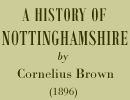< Previous | Contents | Next >
Upton, Hockerton and Winkburn
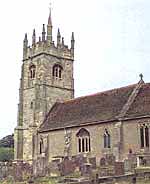 St Peter's church, Upton (A. Nicholson, 1984).
St Peter's church, Upton (A. Nicholson, 1984). The next village to Averham on the road to Southwell is Upton, whose Perpendicular church-tower is a feature in the landscape, and bearing to the right is the still smaller village of Hockerton. There are some remains of Norman work visible in the church there, and on the south side of the chancel an arched recess, in the centre of which a small niche has been inserted. The end of one of the old benches, of late Elizabethan work, has been preserved, and the tops of the new benches are appropriately modelled after this pattern in poppy-head design. There are no memorials save a modern mural tablet; but in the tower is part of a slab to a former Rector, temp. 1486.
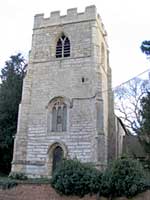
St Nicholas' church, Hockerton (A. Nicholson, 2005).
To Hockerton Thoroton has devoted more than ordinary attention, inasmuch as a large portion of it belonged to Gilbert Boun, his father-in-law. It appears from his record that in the twelfth and thirteenth centuries various gifts were made by property owners to the Abbey of Rufford. Hubert de Hokerton gave to the monks four selions of land, but in return they were to grant him their brotherhood, and after his death to do for him as for a convert. And with a due regard for his bodily as well as his spiritual welfare, he stipulated that the monks should provide him each year at Michaelmas a pair of shoes or 4d.—the shoes, no doubt, preferred. It was customary in those times to sign with a seal, but Master Hubert did not possess one, so he borrowed that of the Chapter of Southwell, and caused it ‘for a testimony’ to be hung at his chartel. Following the family who took their name from the village came the Butilers, who were at Hockerton until the days of Henry VII., and another old family who also held property in the parish at a similar period was the family of Criche. In the time of Henry VI. the Criches sold their lands to John Hunt, Merchant of the Staple, and from him they descended in part to Isabell, wife of Edward Boun, grandfather of Gilbert Boun, serjeant-at-law, and father of Mrs. Thoroton.
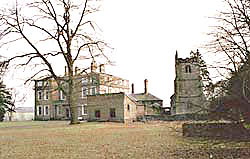
Winkburn Hall and the church of St John of Jerusalam. (A. Nicholson, 1988).
We must pass on, however, without further delay to Winkburn, and the drive through the park is one of unusual beauty. The country is well wooded and undulating, and the scenery is very picturesque. Winkburn lies in a pretty valley, watered by the river Winkle, the central points of interest being the venerable church and the Hall (dating from the last century), which are side by side, forming a happy combination of the ancient and the modern. The mansion of brick, the abode of Colonel Burnell, J.P., has a pleasing elevation, and the park and grounds which it overlooks are of considerable extent. The church contains in its architecture distinctive traces of the Norman period, and within it are the high-backed pews familiar to our forefathers. Some time in the twelfth century both church and town of Winkburn were given to the Knights Hospitallers of St. John of Jerusalem, one of the military orders of the religious, who were introduced into this country about A.D. 1100. The Knights retained possession until the seizure of monastic property by Henry VIII., when Winkburn reverted to the Crown, and was granted by Edward VI. to William Burnell, Esq., and Constance his wife, with whose descendants it still remains.
In 1588 the manor appears to have been occupied by Elizabeth, Countess of Rutland, as there are in the Belvoir Manuscripts numerous letters from her ladyship dated from Winkburn. John, Earl of Rutland, died in March, 1587-88, and it is probable that the house would be taken for awhile by the widow, as affording a peaceful seclusion from the troubles and anxieties of public life at the Court of Queen Elizabeth.
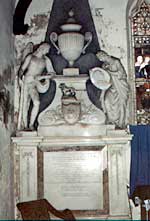
Monument to D'Arcy Burnell, 1774 (A. Nicholson, 1988).
After the temporary occupation of Winkburn by the Duchess as tenant, the owners resumed possession of their estate, the head of the family resident at the Hall being William Burnell, Esq., to whom there is a fine monument on the south side of the east window. A marble monument is erected to D’Arcy Burnell, who died in 1774, and another interesting memorial is a beautiful brass on the north wall to Hugh D’Arcy Pegge Burnell, Colonel commanding 7th Queen’s Own Hussars, born July 16, 1836, died December 18, 1883, erected in loving memory by the officers and non-commissioned officers who served with him in the regiment. On the brass is inscribed Dettingen, Peninsular, Waterloo, and Lucknow, with the monogram of the regiment above and the arms of the Burnell family below.
